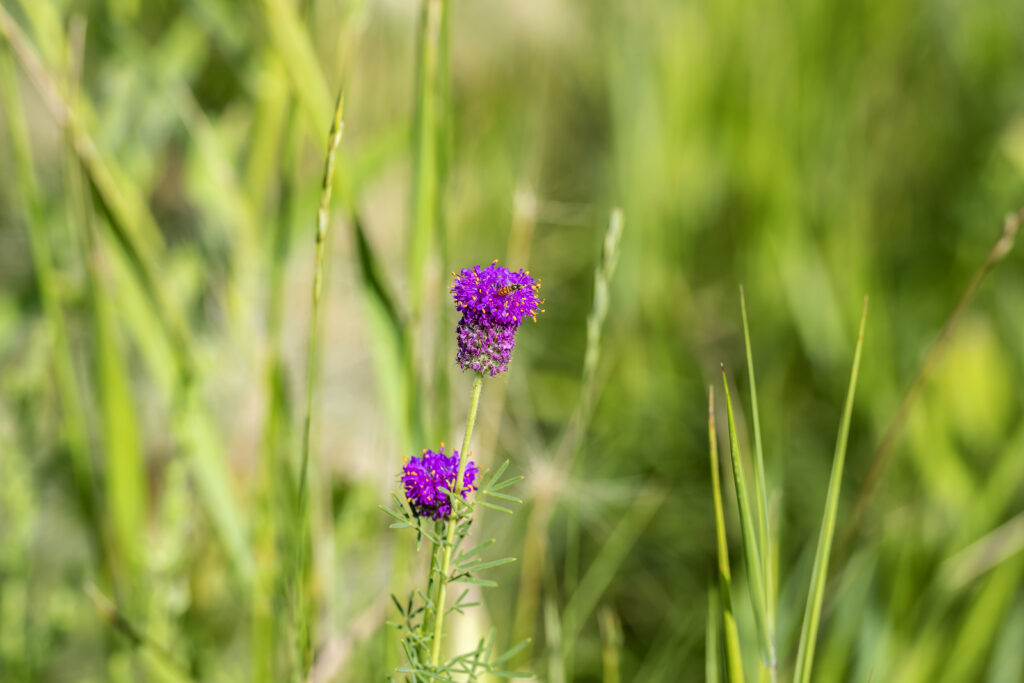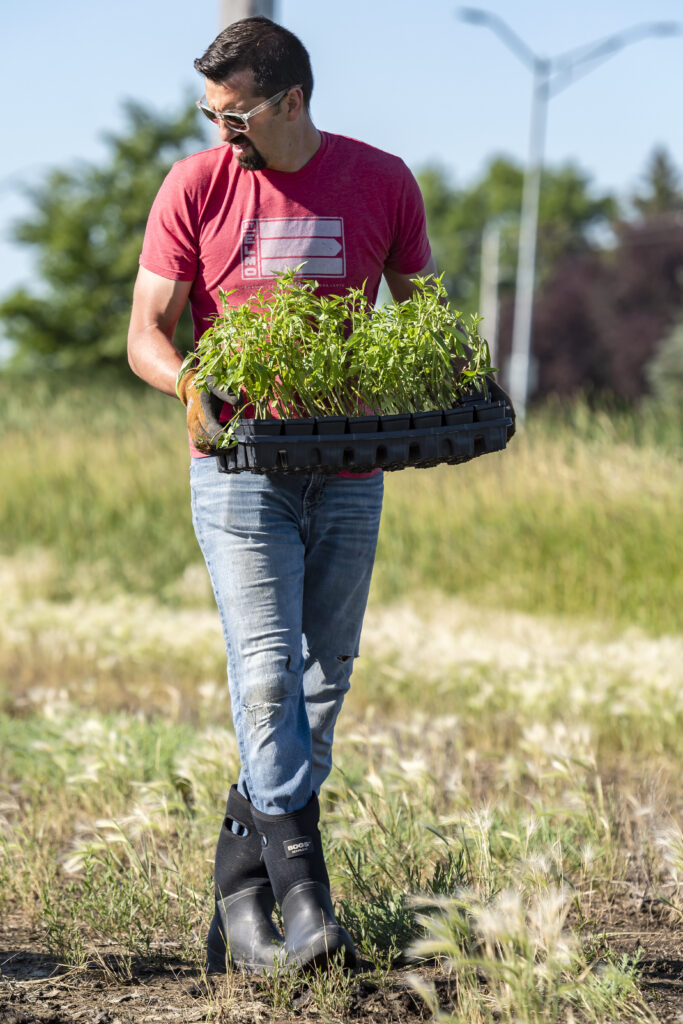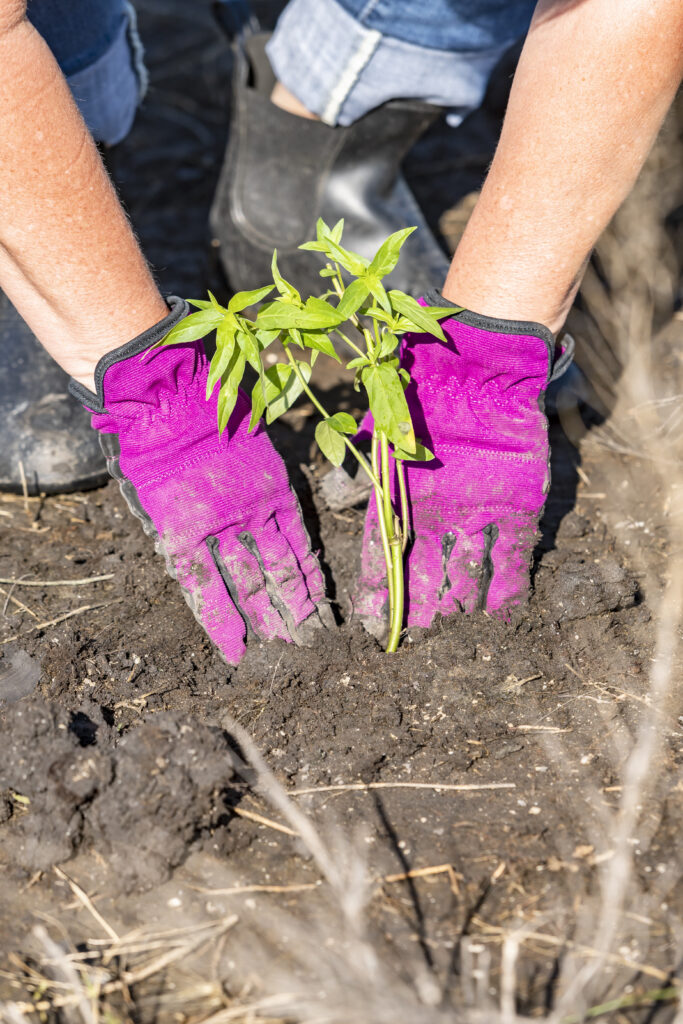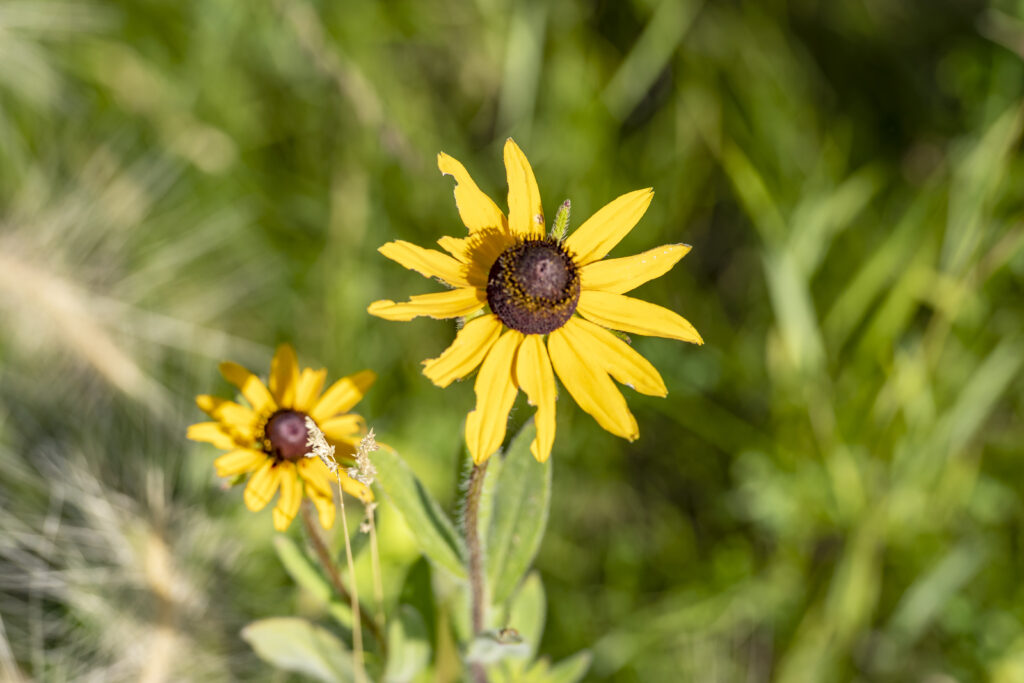

The first major windstorm of 1933 swept through South Dakota on November 11. Some farms lost all their topsoil in a single day. The next morning the sky remained dark until noon – one part air to three parts dust. No one knew this was just a preview. (Dirt: The Erosion of Civilizations, by David R. Montgomery, 2007)
The devastating and deadly derecho with its massive cloud of dirt that tore through eastern South Dakota in May 2022 reminded many of the Dust Bowl storms of 1930s America. A few months earlier, I had heard a story from Jared Hohn and Jamie Risse about driving to Sioux Falls from, ironically, a soil health conference in Aberdeen when they saw dirt on top of snow drifts, obviously blown there by winter winds. The loose topsoil was a sign of the times and something Jared, Jamie, and their employers, Aberdeen’s Presentation Sisters, are trying to address in their own local way.
The Sisters have been locals since taking up residence in Aberdeen just a few years after the city’s founding. They promptly became pioneers in education, health care, and many other important pursuits in the area. In the early 1950s, they moved from the middle of town into a convent they built on the north side, a 100-plus acre property that became known as Presentation Heights. Nearly 70 years later, facing a decline in their numbers, they reevaluated their future. Two decisions were reached. First, in 2021, they left the convent for Presentation Place, a new residence they built next to Manor Park. That was one result of the process of discernment about what to do with the convent and its large carbon footprint. The ultimate use of the building is still being determined.
Second, they also considered what to do with the land. Reflecting on their mission as well as teachings from recent popes on the environment led them to commit to restoring the land to what it was like before the Sisters arrived in the area. “The decision was how best to steward the land,” said Sister Mary Thomas, elected President of the congregation in spring 2022. “We acknowledged we are the current occupants of land once occupied by American Indians.” That was part of a “gradual dawning” about living “more in harmony with our neighbors – not just people, neighbors.” That is, including the life in the ground and how “soil health was connected to our health.” By returning the land to its earlier state, they seek to highlight a way of addressing soil challenges that is both new and ancient.
Common Challenges
Dirt, the book quoted at the beginning here, has been a resource for the project. It documents the challenge humans face regarding soil depletion and shares daunting facts. Let one suffice: “Across the planet, moderate to extreme soil erosion has degraded 1.2 billion hectares of agricultural land since 1945 – an area the size of China and India combined.” This is a pace well ahead of the natural rate of topsoil creation, potentially creating a shortage of perhaps the most valuable resource of all, the soil from which comes most of our food.
“The dire straits the Earth is in – if we liken it to a medical condition – in some ways we’ve already crossed over,” Sister Mary asserted. “What we bequeath to our grandchildren won’t be like what it is today. So, we need to address it now. All the things that are part of problems—fires in the west, migrations of people—it’s the cry of the earth and cry of the poor. We want to use our little part of land to bring awareness to social issues.”
The added italics above come from one of the inspirations for their planning, Pope Francis’ encyclical Laudato Si (2015, the title is Italian for “Praise Be to You,” with the subtitle “On Care for Our Common Home”). The Sisters’ vision is foreshadowed in the document’s call for action: “Once we start to think about the kind of world we are leaving to future generations, we look at things differently; we realize that the world is a gift which we have freely received and must share with others.” Adopting the pope’s promotion of integral ecology, the Sisters hired Jared and Jamie as Integral Ecology Specialists to create what might be considered a demonstration project on their property for how to reclaim the growth and regeneration that nature – the Sisters might say, the divine plan – does well, naturally.
Jared defines integral ecology simply, “Everything you do – everything you say, every action – is connected to something else. Everything is connected.”
“It’s all connected,” Sister Mary agreed. “We’ve been saying that on a spiritual level. Now we need to say it about the Earth. It’s not just spiritual.”
Native Prairie Restoration
What did the land look like before farming came to our area?
As far as the eye can see, the land we are surveying is flat as a barn floor and tall grass covers a black soil that is 8 to 12 inches thick. There are no trees except along the James River. What a land for breaking plows! (1870s government surveyor quoted in Early History of Brown County South Dakota by the Brown County Territorial Pioneer Committee, 1970)
One of the Presentation project’s earliest resources was North Dakota farmer Gabe Brown, author of Dirt to Soil: One Family’s Journey into Regenerative Agriculture (2018). He successfully adopted many restorative practices, such as diversity in the soil (both in crops and necessary microorganisms), reintroduction of grazing to planted fields, cover crops, and others. All of this is based on no-till farming to reverse the soil degradation caused around the world and throughout history by plowing and consequent practices that dry and loosen the soil, making it susceptible to erosion – making it dirt.
Among the neighbors with whom the Sisters seek harmony are farmers, who have inherited practices that for millennia seemed the best – maybe the only – way to feed people. But a system that reduces soil quality makes the future more difficult for them and for the rest of us who depend on – and demand from – them. It’s a global issue for which all need to accept responsibility. Growing population coupled with exponentially higher consumer demand drive agricultural production, to say nothing of other industries that complicate Earth’s plight. It’s not about blaming farmers; it’s a universal call to action.
At the same time, many farmers have paid attention and adopted soil conservation practices, says local farmer Mike McHugh. “After the derecho and the dust settling, there were many days this spring and summer that had excessive winds, comparable to the Dirty 30s, and there was minimal erosion of soil because of the tillage practices employed in today’s farming practices. I’m not saying they are perfect, but as we no longer live in a hunter/gatherer environment, we have to produce the food and fiber needed by an urban society.” He adds, “Farmers today are producing three to four times the yields that were produced 50 years ago and utilizing one-fourth to one-fifth the amount of fossil fuels per acre that were used at that time. Most have the goal of working with Mother Nature and the environment to produce the bounty we need to continue our existence.”
In his book, Brown asks a fundamental question for farmers as well as all of us: “how much is the soil acting like that of a prairie? An integrated, holistic approach is required in order to mimic the complexity and fertility of a prairie ecosystem on the farm.” Echoing this, Dirt points to Xenophon, a fourth-century BC Greek farmer who promoted adapting agriculture to the land rather than the land to agriculture. In his book, Brown mocks himself when he ignores this common sense. After he complained that their corn yields were not as high as some, his son responded, “Dad, don’t you think that you are trying to outproduce our environment?” The comment made him realize, “Nature does not care about yield and pounds, nature cares about enduring.” Nature knows what it’s doing, and the Sisters are trying to listen.
Land in the City
The Sisters aren’t restoring farmland, but the principles are similar to Brown’s. “The approach differs strategically from Gabe,” who’s trying to turn a profit, Jared says, “because he uses cover crops to put in what he needs to get his outputs for his cash crops.” Rather, he adds, “We are just reestablishing native prairie, but we’re both aiming to be natural, to get more nutrients in the soil. We’re both creating organic material that will regenerate the soil, allow for more infiltration of water and be naturally healthier for plants and people working around it.”
The 24-acre project area has likely never been plowed, and Jared says the land is “pretty natural. There’s about one inch of sandy soil on top, and under it is a rich, thick, somewhat clay-ish soil.” Still, the relatively healthy area was full of fast-growing and invasive species of flora, sometimes brought by European settlers. As the pair learned more about the grasses that had once covered the Plains, they realized these foreign species had crowded out what had grown here for centuries. They needed to learn how to restore the prairie.
Following what became a near mantra, “The Sisters do nothing alone,” Jared and Jamie didn’t either. They “started reaching out to people who have done something like this – restoring a prairie,” Jamie said. Carter Johnson, a retired SDSU professor and a founder of EcoSun, a farm near Colman, South Dakota, which restored the prairie, came to Aberdeen and advised on planting.
First, they had to make room for the past. They reluctantly used chemical herbicides to try to eliminate the invasive brome grasses. Then, with Brown County extension agent David Dutenhoffer’s help, they followed Johnson’s recipe of planting thirty species of native grass and wildflowers. “Everything we do is in the top quarter-inch or so of soil,” Jared said. “We seed it shallow, then let it grow. We mow if needed. The goal is as little agitation as necessary.”
In 2021, “the soil was so dry and crusty, you couldn’t even call it soil,” Jamie said. “It was bleak. The seeds didn’t take for a while.” In that parched summer, they dragged 600 feet of hose from the Sisters’ artesian well to water their plants. Jamie also got a big rain gauge, set it in the ground, and asked God for help. “Then it rained and rained,” she said. “It went almost from drought to flood.” Despite disappointing results, they also planted cold weather grasses in September – and hoped and prayed.
Recalling the dry 2021, Sister Mary Thomas remembered the farmers. “Last summer our livelihood was not dependent on whether seeds sprouted,” she noted. “Theirs is.” Recognizing farmers’ central role in human health and posterity, she added, “They also join us in wanting to leave a rich legacy to grandchildren.”
Continuing the theme of doing nothing alone, Jared and Jamie got help from many locals. “We used mowers from the Brown County Transportation Department and a tractor from the Brown County Fair,” Jared said. “The City of Aberdeen helped too. We worked with the city engineer, arborist, fire marshal, and zoning board, who allowed growing grasses taller than standard.”
Coping with a Wet 2022
They entered spring 2022 with two primary goals. First, they would plant rose milkweed and cord grass along the wetland areas to help ensure a natural border, vary the plants there, and provide habitat for native animals that prefer wet conditions. Second, they needed to manage invasive weeds.
Their best laid plans had to wait, however, because again the weather didn’t cooperate. Part of the project area receives water drainage from the city, and the area was flooded through most of the spring. In May, Jared noted, “For now, we wait until the water recedes and dries out before moving forward.”
Finally, about two months later, they were able to return to the project area in early summer. After having been in Aberdeen almost weekly in 2021, this would be only their second visit in 2022. “Last year, nothing grew. We were like, oh, what did we do?” Jamie lamented. “I was a little fearful of what I was going to see when we drove up today.”
They were thrilled with what they saw. The plantings from last year, which produced nothing in 2021, were blooming. Milkweed, black-eyed Susan, prairie cone flower, cord grass, prairie drop seed, and side oats gramma all showed vigorous growth. The invasive brome and thistle were significantly reduced, allowing new plants to grow as well as some long dormant native flora to return, such as salt grasses and asparagus. Jared said, “We were told stuff would sleep, creep, then leap up!”
In addition to appreciating their handiwork, Jamie and Jared spent that day planting 250 cord grass shoots near dry salty land. A few weeks later, they spot mowed and hand cut the thistle, then nearly tripled that earlier effort by working with other Presentation staff to plant another 640 plugs. Also helping with the work was Jared’s eight-year-old son, Korben, a sign that future generations are ready to receive.
As the summer wore on, Jared and Jamie were able to return to their 2022 goals. Still, the drought, moisture, setbacks, and satisfactions make it clear that “the process takes years,” Jared said. “Eventually the native plants will take hold and grow.” Patience is a virtue, but Mother Nature has all the time in the world. We may not see the difference from a distance. Driving by the Heights, we may see little change. But the land will know.
Legacy
The project may suggest an uncomfortable metaphor. It may prickle to understand ourselves as the brome or thistle, invasive weeds that have crowded out the native species and which now have to recede for a healthier prairie. It would be better, however, to see in the project and in the successes of similar efforts that, while we are responsible for the unintended consequences of tilling the soil, we are also responsible for and capable of its repair if, following the Sisters’ mantra, we work together.
Consciously or not, the project is partly about the Sisters’ legacy—what they leave behind and what they inspire in others. Sister Mary Thomas said, “We wanted to create a place where people can walk through and awaken in them the desire to do the same thing with their land. To have a desire to be in relationship with the land and the flora and ultimately with the Creator of it all.”
It’s a vision that fits with a note in Laudato Si about Saint Francis who invites us to see nature as a magnificent book in which God speaks to us and grants us a glimpse of his infinite beauty and goodness…. For this reason, Francis asked that part of the friary garden always be left untouched, so that wild flowers and herbs could grow there, and those who saw them could raise their minds to God, the Creator of such beauty. Rather than a problem to be solved, the world is a joyful mystery to be contemplated with gladness and praise.
“We as humans live in a world out of balance with nature,” Jamie said, summarizing the importance of the project. Then she quoted Laudato Si, “All it takes is one good person to restore hope!”
Jamie, Jared, the Presentation Sisters, their staff, and friends, no one doing it alone. That’s a lot of hope. //



























